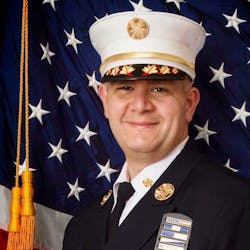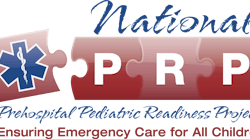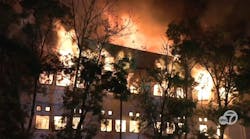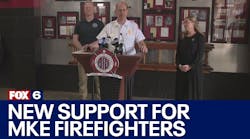It may seem that there have been some brutal attacks on firefighters and EMTs recently. It's true, but sadly it’s not new.
Just this past spring, Prince George’s County, MD, Firefighter-Paramedic John Ulmschneider and Volunteer Firefighter/EMT Kevin Swain responded for a welfare check of a person with a known medical issue. As the firefighters entered the property, the suspected patient opened fire on them. Ulmschneider was killed. Swain was shot four times and survived.
In Lexington, KY, Fire Lieutenant Brenda Cowan, 40, was shot and killed in the line of duty on Friday, Feb. 13, 2004. The crew was helping a woman at a domestic violence incident when they came under fire. The event became a standoff that lasted several hours until the suspect was taken into custody.
In July 2008, Maplewood, MO, Firefighter/Paramedic Ryan Hummert was shot to death at a vehicle fire. He simply got off the truck to attack the fire and was gunned down.
On Dec. 24, 2012, Mike Chiapperini—a Webster, NY, police lieutenant and PIO who was off duty, serving as a West Webster, NY, volunteer firefighter—had just returned from Long Island after being deployed for Hurricane Sandy. Chiapperini and Tomasz Kaczowka, a 9-1-1 dispatcher who was off duty, also serving as a West Webster volunteer firefighter, were both shot and killed upon arriving on the scene of a fire. Firefighters Theodore Scardino and Joseph Hofsetter were also shot but survived.
Risks beyond fire
While most people think the firefighting operations pose the main risk to firefighters, we know that the risk goes far beyond that. More and more departments are staging and awaiting law enforcement before sending in their members. Others are issuing ballistic vests, and some have even discussed arming their personnel. It is safe to say that most fire/EMS departments are taking a much closer look at their risk and exposure. While we always size up fires, we must also size up every run we make to determine what we want to accomplish and whether we have the resources to do so.
This month, we will learn about Rob Cabano, a decorated fire chief for the North Babylon Volunteer Fire Company on Long Island, NY. Cabano—a seasoned, certified paramedic and veteran fire officer—responded to a nearby medical emergency that ultimately resulted in an extreme close call.
Following is a first-hand account by Chief Cabano.
Trouble at the neighbor’s house
On the night of April 1, 2016, I was returning home from dinner with my fiancé at 10 p.m. As I arrived at my home and opened the door to my chief’s vehicle, we heard screaming for help. At that time, my neighbor had ran over to my truck distraught and advising me her son Christopher, age 29, might be dead from a possible overdose. I radioed in to Babylon Central Fire Alarm for an immediate response to an overdose.
I retrieved my EMS equipment from my vehicle and ran into my neighbor’s house. Upon my arrival, I found an unconscious/unresponsive male, completely cyanotic and in respiratory arrest with a weak and thready pulse. There was drug paraphernalia in the room suggesting that this was an opiate overdose. I took my Narcan from my bag and administered one dose of 2 mg intranasally. Once that was done, I assisted his respirations with a BVM. After reassessing the patient, there was no change in status, so I administered another dose of Narcan intranasally and continued to assist with his respirations.
Patient breathing, then abusive
About 30–60 seconds later, the patient began breathing on his own and was able to sit himself up against his bed. I said, “Hey Chris, it’s Rob, the fire chief from next door. You overdosed. I am here to help you.” At that moment, the patient became enraged and verbally abusive and immediately, with no warning, physically abusive. As he attempted to take his first swing at me, I was able to block his arm, but he was able to grab hold of my arm, pull me down and immediately kick me in the head.
As I was stumbling down, I felt another blow to my head with his fist. I fell on top of him, and we wrestled around for 5–10 seconds that felt like hours. Second Assistant Chief James Harrington III arrived and attempted to assist me, but got pushed off of us. I could hear Harrington talking on the radio requesting immediate police assistance. The patient was able to get on top of me in a “full-mount” position. I saw his arms go up, and I remember thinking that he was going to elbow me in the head. I covered my face and turned my head, wanting to try to roll to my side, but I couldn't due to the amount of open syringes laying next to me on the floor. I felt a couple blows strike me and my head hit the hardwood flooring. I immediately knew something had to be done or I was going to die.
I got the strength to sit up and push him off of me, and I grabbed him by the waist and was able to get on top of him. He immediately began reaching under his bed—but for what? I didn’t know, but my fear was a weapon. I tried to gain control of his arm, but he was able to elbow the side of my head with his other arm until I was able to tuck my head into his back. I heard the police officer coming up the stairs, and I new I was going to be OK. The officer was able to handcuff the patient, meaning the fight for my life was over.
This may sound like a long time, but after I reviewed the audiotapes and the alarm times, I was able to determine that the time from when I called this in to when the patient was handcuffed was just 5 minutes.
Rescuer needs rescuing
When we brought the patient outside and my adrenaline was slowing down, I immediately felt ill. I was dizzy, nauseated and I had a large lump on the side of my head from the assault. I was transported to the hospital where I was evaluated and diagnosed with a concussion.
Three days post injury, I started to develop speech issues and visual disturbances. At some points, I had a stutter and at other times I would think about what I had to say but couldn't say it. My balance was completely off. I would pick up small objects like a glass of water and drop it, or I would walk and feel like I was going to fall. I could not stand on one leg without falling over.
I was transported back to the emergency room for more brain scans, and fortunately, this was just my concussion playing its course. I saw a concussion specialist, and the course of action was to let the symptoms play out for two weeks and then be reevaluated. I did and the speech issues eventually subsided. I still at times have a stutter, but I barely even notice it.
As for my vision, I saw a specialist who deals with head trauma patients. Through testing it was found that I was struck so hard that it ruined my ability to see long distances, and I am now required to wear glasses all day long. This improved my vision, my headaches and my balance. I actually felt like me again. Additionally, I will see an ENT to be evaluated for recurring hearing problems.
I was out of service and out of work for five weeks, but I am back to full duty, and so far, so good.
Legal aftermath
The patient/perpetrator was arrested and originally charged with a misdemeanor Assault 3. I had worked very hard with the District Attorney’s office because I felt this was the wrong charge since I was operating as a first responder. After a few phone calls and a lot of letters to the DA's office from surrounding townships to call for the charges to be upgraded, I was called to testify in front of a grand jury. After my testimony, the patient was indicted on Felony Assault 2 and one misdemeanor count of obstruction because I was unable to continue treating him since he caused injury to me.
He is due back in court, and I have a temporary order of protection from him. My last conversation with the Assistant DA was that the perpetrator’s attorney was asking this to be brought to "Drug Court.” Basically with this court, he is given one year to enter a drug program and he has to stay clean for one year, verified through weekly drug tests. After he is able to complete this for one year, they will ask to drop his Felony Assault charge. However, if he fails at this program, he faces stiffer charges. To be honest, I do not know how I feel about this. It is upsetting to me that this man has or had a problem, in my eyes knew what he was doing, and he will walk away with the potential of no jail time. I was simply volunteering my time to help, after enjoying a great evening with my fiancé. I saved this person’s life, and he injured me for the rest of mine, and if this is going to drug court, he has the potential to walk away with minor charges.
I feel this is unfair treatment to fire/EMS providers. Studies show the rise of violence against fire/EMS personnel, and it will continue to grow until the lawmakers keep these people behind bars for their actions.
I wanted to get this story out now because in my region—and I am sure in others as well—there is a tremendous push for public access Narcan training. I have been on this job for a long time, and I would estimate that I have treated 200-plus opiate overdoses in my career.
We all know as trained providers that these people may not be “nice” when they wake up. They can wake up startled, altered and angry. My fear is that someone who isn't medically trained and has no field experience is going to administer Narcan to John Q. Public, only to end up in a dangerous situation. I am not saying this is a bad program; I am just saying more training and awareness needs to be given to all public access Narcan-certified people.
From Chief Goldfeder
First, we wish Chief Cabano continued success as he recuperates from this act of violence. Not surprisingly, he is refusing to let the injuries slow him down.
Clearly, just by reading the chief’s account, there is much to be learned here. As we do with fires and other emergency calls, we size up. We need to make sure to do the same thing on every run, especially the ones we all respond to 85 percent of the time—EMS runs. In this case, Chief Cabano responded to help a neighbor, and actually saved the man’s life—and was then repaid by a violent and life-changing encounter. Even when sizing up, as he did, there will be times where bad outcomes may not be avoidable.
The National Fallen Firefighters Foundation has published a document titled "Nine Questions You Should Ask." It is the result of the work of Chief John Oates of East Hartford, CT, based on the report from a focus group of fire, EMS and law enforcement leaders held recently in Baltimore. That report has identified 14 National Recommendations to identify potential risks and survive. Following are the nine size-up questions you should ask that could help keep you and your firefighters stay safe in a potentially violent situation. As proven by the shooting LODDs of the two West Webster, NY, responders, not every violent incident can be anticipated.
Nine questions
- Do you use risk/benefit analysis for every call? Size up initially and continue it. Pay close attention while doing your job.
- Do you have an effective relationship at all levels with the law enforcement agencies in your community? Plan, determine procedures, and then drill.
- How good is the information you get from your dispatcher? It's important that dispatchers keep no secrets and share all info with all responding agencies equally and simultaneously.
- Do you allow members to “first respond” directly to the scene? If so, what are the policies related to that? Are they radio-equipped?
- Does your law enforcement agency use an incident management system? What's THE system used by all local agencies, and how often do your drill and train on them?
- When responding to a potentially violent incident, do you seek out a law enforcement officer when you arrive? Just like at a fire, disciplined and policy-based command, control and accountability are paramount.
- Have you told your fire officers/personnel that it is OK to leave the scene if things start to turn bad? Discuss and provide guidelines on when it would be time to get out.
- Is there a point where you don’t respond or limit your response to violent incidents? Do you stage? Where? Based upon what?
- Is your uniform easily mistaken for law enforcement? Many departments are reconsidering their uniforms to look less like law enforcement and more clearly fire/rescue/EMS.
While violence against fire and EMS personnel can cover a wide range, the risk of assault in the performance of EMS duties is roughly 30 times higher than it is with a citizen, according to the National Association of EMTs.
According to DT4EMS.com, injury through assault remains a widely recognized, but little acknowledged, problem threatening emergency service personnel. Many EMS and fire personnel admit to being attacked by a violent patient, an angry bystander or upset family member. The frequency of assault on our fire and EMS providers is alarming, and while most attacks are not life-threatening, the risk of serious injury is evident and unpredictable. Responders require a reasonable, liability-conscious, effective means of preventing and avoiding assault, before it occurs, and defending themselves once attacked.
Kip Teitsort, founder of DT4EMS.com, explains that the mindset of responding personnel has to change. Firefighters, EMTs and paramedics must understand that it is not acceptable to be assaulted while on the job. To start to change this culture, every assault has to be reported and prosecuted. It would not be considered acceptable in any other line of work for a person to assault another and expect not to be punished for it. Just as all people are held accountable to the law, those who assault EMS workers have to be held accountable as well. Firefighters and EMTs who have been assaulted must file reports and pursue criminal charges against their attackers in each and every instance. And the agencies that the EMTs and paramedics work for must encourage their employees to file these reports and charges, as Chief Cabano did.
Based upon the experience of Chief Cabano (and so many other newsmaking events), it's essential that firefighters and EMTs be focused on initial and continuous size-up and scene awareness. While we arrive always willing and always focused on helping someone, many of our brothers and sisters did the same and the situation ended with devastating results.
We urge you to reach out to local law enforcement agencies to train and plan for these kinds of events. Visit the websites for the NFFF, IAFF, IAFC and USFA for related documents and training materials. Learning, training and actually drilling on and using scenarios to practice on what Gordon Graham calls these low-frequency/high-risk events can go a long way in us all going home.
Our sincere thanks to Chief Cabano for his willingness to share his Close Call with our readers. Additional thanks to the North Babylon Volunteer Fire Company members, the Suffolk County Police Department and the Babylon Central Fire Rescue Alarm dispatchers.
Dedication
This month’s Close Calls column is dedicated to the life and memory of Prince George’s County Firefighter/Paramedic John E. Ulmschneider. We also continue to wish a successful recovery to volunteer Firefighter Kevin Swain.






